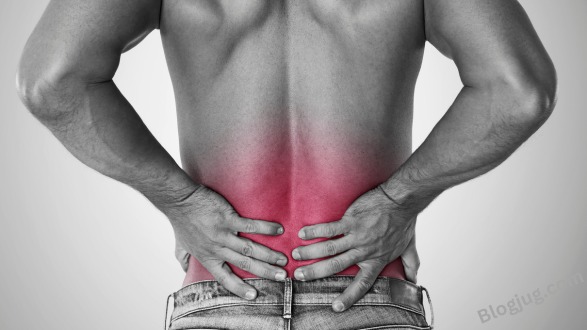Living a normal life and working can be hindered by back pain. It is advisable to consult your healthcare physician as soon as possible rather than attempting to diagnose yourself because there are numerous potential causes of back pain. You can be suffering from a simple ailment like a strained muscle or you might have an underlying illness like endometriosis or kidney stones.

What is back pain?
Your back pain might range from a bothersome discomfort to an excruciating pain. Following colds, back pain is the second most prevalent reason that patients see their doctors. Many miss work as a result of it. In the US, between 80% and 90% of people will have back discomfort at some point in their life.
What are the types of back pain?
Medical specialists define back pain in several ways. You can categorize your back pain according to its location, such as left, center, or right side upper, middle, or lower back discomfort. You can also describe other forms of pain to your medical professional. How severe, moderate, or light is your pain? Is it more of a small, sharp stab or a large ache? Additionally, the duration of back discomfort can be used to categorize it. An abrupt, quick episode that is frequently connected to an injury is called an acute episode. You have chronic or persistent back pain if it has persisted for longer than three to six months.
How common is back pain?
Pain in the back is fairly common. Back pain is the most common cause of disability among American workers, accounting for 2% of all cases of incapacity to perform everyday tasks.
Who is at risk for back pain?
The likelihood of developing back discomfort increases with age. Additionally, you run a greater risk if you:
1. Don’t exercise.
2. Already suffer from certain cancers or rheumatism.
3. Are overweight.
4. Raise using your back, not your legs.
5. Use tobacco goods or smoke.
6. Experience despair or anxiousness.
Symptoms and Causes
What causes back pain?
There are two types of back pain: radiating back pain, which originates in an organ and travels to your back or feels like it does, and local back pain, which originates in your spine, muscles, and other back tissues. Here are some instances of both:
Local back pain
1. Arthritis.
2. Radiculopathy.
3. Tumor.
4. Trauma/injury.
5. Ankylosing spondylitis.
6. Spondylolisthesis is caused by degeneration.
7. Degeneration of the intervertebral disk.
8. Abnormality of the sacroiliac joint.
9. Deterioration of the spinal disk Spondylolisthesis.
10. Spondylolisthesis.
11. Spinal stenosis.
Localized back discomfort in your tissues may be caused by :
1. An injury to a ligament.
2. An ailment of the muscles. Muscle strains account for 85% of back pain cases in the United States.
3. Muscle tightness.
Radiating back pain
Back pain radiating may caused from:
1. Liver problems.
2. Pancreatitis.
3. Appendicitis.
4. Abdominal aneurysms of the aorta.
5. Cancers(very rare).
6. Both myofascial pain syndrome and fibromyalgia.
7. Infections (very rare).
8. Inflammation of the gallbladder.
9. Renal stones and kidney infection.
10. Inflammatory disorders of the pelvis.
11. Ulcers puncturing the stomach.
12. Infections of the urinary tract.
Radiating back pain in women or those who were assigned female at birth (AFAB) may result from:
1. Pregnancy.
2. Endometriosis.
3. Uterine fibroids.
Radiating back pain in men or those who were assigned male at birth (AMAB) may caused from:
1. Torsion or damage to the testicles.
How long does back pain last
A day, a few weeks, months, or even a lifetime may pass with back discomfort. The reason and the course of treatment determine how long it takes.
Is back pain a symptom of pregnancy?
That’s possible. Back pain is common among expectant women.
Can back pain be a sign of cancer?
It is incredibly uncommon; back pain signs cancer only 1% of the time.
Diagnosis and Tests
How is back pain evaluated and diagnosed?
Frequently, your doctor will obtain all the necessary information by asking you about your symptoms, medical history, and lifestyle before performing an examination. Nonetheless, imaging testing are occasionally required. These could consist of:
1. MRI.
2. X-rays.
3. EMGs.
4. CT scans.
5. Bone scan. ———
Which healthcare providers evaluate and diagnose back pain?
Most of the time, your primary care physician can diagnose and identify the reason for your back discomfort. They will arrange tests and/or refer you to a specialist if necessary. Potential experts consist of:
1. A physiotherapist.
2. An osteopath.
3. A chiropractor.
4. A spine specialist in medicine with a focus on back pain.
5. A specialist in bones and joints in orthopedics.
If you’re having trouble managing your pain, your healthcare professional can also suggest seeing a therapist or psychiatrist.
What inquiries might a medical professional make to identify back pain?
Your doctor will inquire about any self-injuries, the duration of your back pain, and the intensity of your pain. Your medications and any additional medical conditions you may have must be disclosed to them. Inform your provider if any of your family members have experienced comparable problems. They might also inquire about the following:
1. Can you work daily?
2. Does your line of work include lifting objects?
3. Which pastimes make your back ache worse?
4. Do you have any other symptoms?
5. Where exactly are you feeling pain?
6. What impact does the pain have on your day-to-day tasks?
7. Which remedies have you tried at home?
Management and Treatment
How long will I have back pain?
This is dependent upon what is causing your backache. For example, if you have an infection, your pain may go gone once the antibiotic course is finished. You might require lifetime treatment if spinal degeneration is the source of your discomfort.
How is back pain treated?
The course of treatment for your back pain depends on its etiology. You might find relief from your back discomfort by using:
1. Heating pads or cold packs.
2. Stretching exercises.
3. Massages.
4. Surgery.
6. Antibiotics.
7. Cortisone.
8. Traction.
9. Physical therapy.
10. Other prescription and over-the-counter analgesics, steroids, and pain relievers.
11. Acupuncture.
12. Exercise, especially exercises that build muscle.
13. Chiropractic care.
How can I lessen the discomfort caused by my back pain?
Use a cold pack for 20 to 30 minutes at a time for the first 48 hours or so if you experienced an acute injury. You could find that switching between a heating pad and a cold pack helps more after that (or if there was no acute damage). After 20 to 30 minutes, leave one there and swap it out. Use over-the-counter analgesics such ibuprofen (Advil®) or acetaminophen (Tylenol®). Get lots of rest and hydration.
Make sure you take all recommended prescriptions, complete all necessary testing, and show up for all scheduled appointments if you visit your provider.
How should I sleep with back pain?
Sleeping on your back, with a pillow beneath your legs to ease pressure on your back, might feel the most comfortable. Try sleeping on your side with a pillow between your knees if this isn’t comfy for you. Avoid going to bed on your stomach.
Prevention
How can I lower my chance of developing back pain?
Some strategies to lower your chance of developing back discomfort include:
1. Exercise.
2. Emphasize using your legs to lift instead of your back muscles.
3. Sustain a healthy weight.
4. Keep your shoulders up. When you sit and stand, maintain a straight back.
5. Give up using tobacco products and smoking.
6. Seek assistance for depression, anxiety, and stress.
7. Put on flat shoes.
8. Regularly stretch.
Outlook / Prognosis
Can back pain resolve itself?
In some circumstances, back pain may go away on its own, but it’s usually advisable to get treatment, particularly if you don’t know what’s causing it.
When will I be able to resume my regular activities?
Discuss a timetable with your healthcare physician for returning to your regular activities. If you adhere to your doctors’ recommended treatments, you might be able to continue working, or you could need to take some time off to relax. Consult your provider to confirm when you’ll be ready rather than winging it.
Can back pain return even after treatment?
Yes, It is possible for bones and muscles to ache again.
Living With
When should I see my healthcare provider?
See a medical expert if your back pain is severe or does not go better in a few weeks. Visit them right away if:
1. Your legs start to feel weak.
2. You experience tingling or numbness in your anus, buttocks, legs, or genitalia.
3. You’re getting thinner.
4. You have edema in your back.
5. Your legs may have pain in one or both legs.
After receiving therapy for four to seven days, you should get in touch with your doctor once more if your discomfort doesn’t go away. If you now experience back discomfort together with: Consult your physician once more right once:
1. Pus or blood in your feces.
2. Fever.
3. Groin pain.
4. Vomiting.
5. Nausea.
6. Pee that is hazy or bloody, has a smell bad, or hurts to urinate.
7. Pain during or after sex.
8. Irregular periods.
9. stomach ache
What inquiries concerning my back ache should I make with my healthcare provider?
Consult your physician as soon as possible to avoid having to deal with back pain. Here are a few inquiries you might like to put to them:
1. What’s the source of my back pain?
2. Does my particular kind of back pain have a name?
3. Will my suffering end on its own?
4. What course of action is best for me?
5. How can I alleviate my discomfort at home?
6. Should I consult a specialist?
7. Can I work or carry out my regular tasks?
8. How can I stop the pain in my back from returning?
When is back pain an emergency?
Call 911 or go to the emergency department if:
1. The pain is intense and abrupt.
2. You have nausea, fever, vomiting, and difficulty controlling your bowels and pee in addition to discomfort.
3. You are unable to carry out your regular activities due to the intensity of your pain.
A note from Blogjug
Back pain might cause major inconveniences to your regular routine. There are a lot of therapy options available to help you get over your back pain and go back to your regular activities.. See your physician to go over your alternatives. Their purpose is to assist.









3 thoughts on “Back Pain Solutions and Strategies”